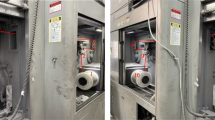Abstract
In this study, the variation in diamond wire tension during the reciprocating wire-winding machining process is investigated to improve the cutting stability and machining precision of a reciprocating winding diamond wire saw. Furthermore, the main causes of wire tension variation are analyzed, a tension control method using a PI (proportional–integral) regulator is proposed, and a wire tension detection and control mechanism is developed to solve the problem of tension variation during the machining process. The performance of this mechanism is verified through experiments, in which polycrystalline silicon materials are cut. Experimental results show that the designed mechanism can effectively mitigate tension instability during the reciprocating wire-winding machining process, control the wire tension fluctuation within 0.6 N, and significantly improve cutting efficiency, cutting surface roughness, and machining dimension accuracy.
Similar content being viewed by others
References
Xie ZH, Wei X, Huang RW (2004) Semiconductor wafer diamond tool cutting technology. Diam Abrasives Eng :10–14
Chiba Y, Tani Y, Enomoto T, Sato H (2003) Development of a high-speed manufacturing method for electrophted diamond wire tools. Ann CIRP :281–284
Satoshi I, Ryoji M (1987) Study on machining characteristics of diamond abrasive wire. Journal of Mechanical Engineering Lab :236–244
Clark WI, Shih AJ, Hardin CW, Lemaster RL, Mcspadden SB (2003) Fixed abrasive diamond wire machining—part I: process monitoring and wire tension force. Int J Mach Tools Manuf 43(5):523–532
Clark WI, Shih AJ, Hardin CW, Lemaster RL, Mcspadden SB (2003) Fixed abrasive diamond wire machining—part II: process monitoring and wire tension force. Int J Mach Tools Manuf 43(5):533–542
Wu H (2016) Wire sawing technology: A state-of-the-art review. Precis Eng :1–9
Du SM, Li SJ, Zhang H (2014) Dynamic cutting force modeling and PID control of SIC cutting process : 68–72
Liedke T, Kuna M (2011) A macroscopic mechanical model of the wire sawing process. Int J Mach Tools Manuf :711–720
Yang SR, Zhang MJ, Wang ZK (2013) Diamond wire constant closed-loop control research. Equip Electron Prod Manuf :38–42
Craig WH, Jun Q, Albert JS (2004) Fixed Abrasive Diamond Wire Saw Slicing of Single-Crystal Silicon Carbide Wafers. Mater Manuf Process :355–367
Wu H, Chris Y, Shreyes NM (2014) Effect of reciprocating wire slurry sawing on surface quality and mechanical strength of as-cut solar silicon wafers. Precis Eng :121–126
Wu H, Shreyes NM (2012) Study of Ductile-to-Brittle Transition in Single Grit Diamond Scribing of Silicon: Application to Wire Sawing of Silicon Wafers. J Eng Mater Technol :041011–041018
Chunhui C, Gow DT, Meng-Hui T (2014) Distribution of diamond grains in fixed abrasive wire sawing process. Int J Adv Manuf Technol 73:1485–1494
Author information
Authors and Affiliations
Corresponding author
Rights and permissions
About this article
Cite this article
Wu, Q., Liu, Z., Zhang, B. et al. Experimental research on tension balance control of reciprocating winding diamond wire saw. Int J Adv Manuf Technol 91, 423–431 (2017). https://doi.org/10.1007/s00170-016-9746-2
Received:
Accepted:
Published:
Issue Date:
DOI: https://doi.org/10.1007/s00170-016-9746-2



